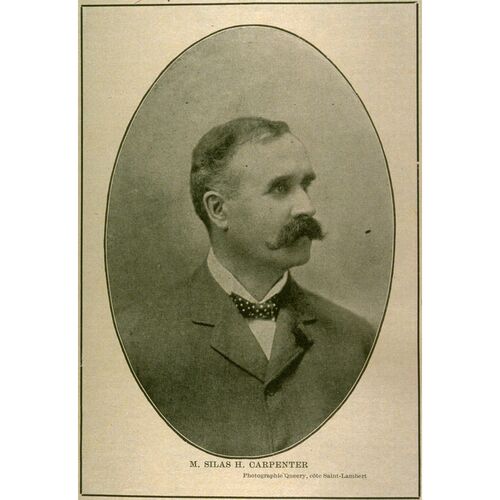CARPENTER, SILAS HUNTINGTON, detective, police administrator, and magistrate; b. 29 Jan. 1854 in Brownsburg, Lower Canada, son of Thomas Carpenter and Margery Sweeney; m. first 1874 Phoebe Gilbert; m. secondly 1896 Clara Trollope, and they had at least six children; d. 1 July 1916 in Banff, Alta.
Silas Carpenter was educated at a local school in Brownsburg and at the Ottawa Collegiate Institute. In 1880 he was appointed constable on the Montreal police force. Promoted sergeant two years later, he was transferred to the detective squad. He remained with the police until 1890, when he resigned to work as a private detective for the Canadian Secret Service Agency in Montreal, a firm he later owned and operated. During this period Carpenter was occasionally employed as a private detective by the federal and Quebec governments. These assignments included acting as a bodyguard for visiting royalty and other dignitaries.
In 1894 a municipal inquiry into corruption and patronage in the Montreal police force called for the establishment of an autonomous detective bureau, whose head would have a free hand in the selection, training, and promotion of his staff. Two years later Carpenter became the first chief of the Montreal detective force at an annual salary of $2,000.
As chief, Carpenter was quick to introduce new techniques in the detection and apprehension of criminals. These innovations included increased cooperation between law enforcement agencies in Canada and the United States and the Bertillon system of identification, which involved the taking of bodily measurements and the description of particular markings or scars, as well as the expanded use of photographs of criminals. During the years that followed, Carpenter was the central figure in many sensational cases in the city. The Montreal Daily Star described him as a “born detective” who thoroughly understood the “criminal character.” In 1908 he was badly wounded by a shotgun blast when trying to arrest John Dillon, the “Mance Street murderer.”
Carpenter became a leading and influential supporter of the Chief Constables’ Association of Canada, which was founded in 1905 to encourage closer ties among police departments, establish a uniform system of police administration, and promote legislation to suppress crime. At its annual convention of 1906 he proposed that Canada adopt the American practice of subjecting habitual criminals to indeterminate periods of imprisonment. Carpenter claimed that habitual criminals could never be reformed and should not be released as long as they remained a threat to the public. His proposal was endorsed by his fellow chiefs. In 1910 he joined with other members of the association in protesting the overuse of clemency by the federal Department of Justice. As president of the association in 1913, he described immigrants of non-British origin as desirable citizens, but stressed that they should conform to Canadian customs.
From the beginning of Carpenter’s appointment as chief of the detective bureau, there had been disagreement over the division of responsibility between the autonomous detective bureau and the uniformed police department. In 1909 an inquiry by judge Lawrence John Cannon* of the Superior Court of Quebec denounced the conflict as detrimental to the efficiency of law enforcement in the city. The subsequent decision by municipal authorities to make the chief of detectives subordinate to the superintendent of police led to Carpenter’s resignation in 1912. Later that year he accepted a position as chief of the Edmonton police force at a salary of $4,000 a year.
In Edmonton civic politics at the time were often dominated by conflicts between moral reformers seeking to banish alcohol, gambling, and prostitution from their communities and those who opposed them. Carpenter’s appointment followed the victory of a reform group. As chief, he mounted a campaign to rid the city of gambling dens and brothels. Not surprisingly, when a group opposed to the reformers won the civic elections of 1914, he was forced from office.
On 14 March 1914 Carpenter was appointed a stipendiary magistrate at Banff by the federal government. With the outbreak of war later that year, he served briefly as registrar of enemy aliens in Montreal until ill health forced his return to Banff. He was buried in Mount Royal Cemetery, Outremont.
NA, RG 2, P.C. 725, 14 March 1914; 2774, 31 Oct. 1914; 732, 14 May 1915. Montreal Daily Star, 3 July 1916. Regina Leader, 3 Feb. 1916. Canadian annual rev. (Hopkins), 1916. Canadian men and women of the time (Morgan; 1912). Tony [A. W.] Cashman, More Edmonton stories; the life and times of Edmonton, Alberta (Edmonton, 1958). Greg Marquis, Policing Canada’s century: a history of the Canadian Association of Chiefs of Police (Toronto, 1993). Jean Turmel, Premières structures et évolution de la police de Montréal, 1796–1909 ([Montréal, 1971]); Le Service de police de la cité de Montréal (1909–1971): étude rétrospective sur son organisation (Montréal, 1974).
Cite This Article
S. W. Horrall, “CARPENTER, SILAS HUNTINGTON,” in Dictionary of Canadian Biography, vol. 14, University of Toronto/Université Laval, 2003–, accessed January 1, 2026, https://www.biographi.ca/en/bio/carpenter_silas_huntington_14E.html.
The citation above shows the format for footnotes and endnotes according to the Chicago manual of style (16th edition). Information to be used in other citation formats:
| Permalink: | https://www.biographi.ca/en/bio/carpenter_silas_huntington_14E.html |
| Author of Article: | S. W. Horrall |
| Title of Article: | CARPENTER, SILAS HUNTINGTON |
| Publication Name: | Dictionary of Canadian Biography, vol. 14 |
| Publisher: | University of Toronto/Université Laval |
| Year of publication: | 1998 |
| Year of revision: | 1998 |
| Access Date: | January 1, 2026 |


![M. Silas H. Carpenter [image fixe] / Quéry Frères Original title: M. Silas H. Carpenter [image fixe] / Quéry Frères](/bioimages/w600.6618.jpg)

